Brazil, Part 5: The Northeast Region
— Brazil — 8 min read
September 19 - 23, 2010
From Sao Luis, I headed east towards the city of Recife and colonial Olinda and then turned south along the coast towards Salvador.
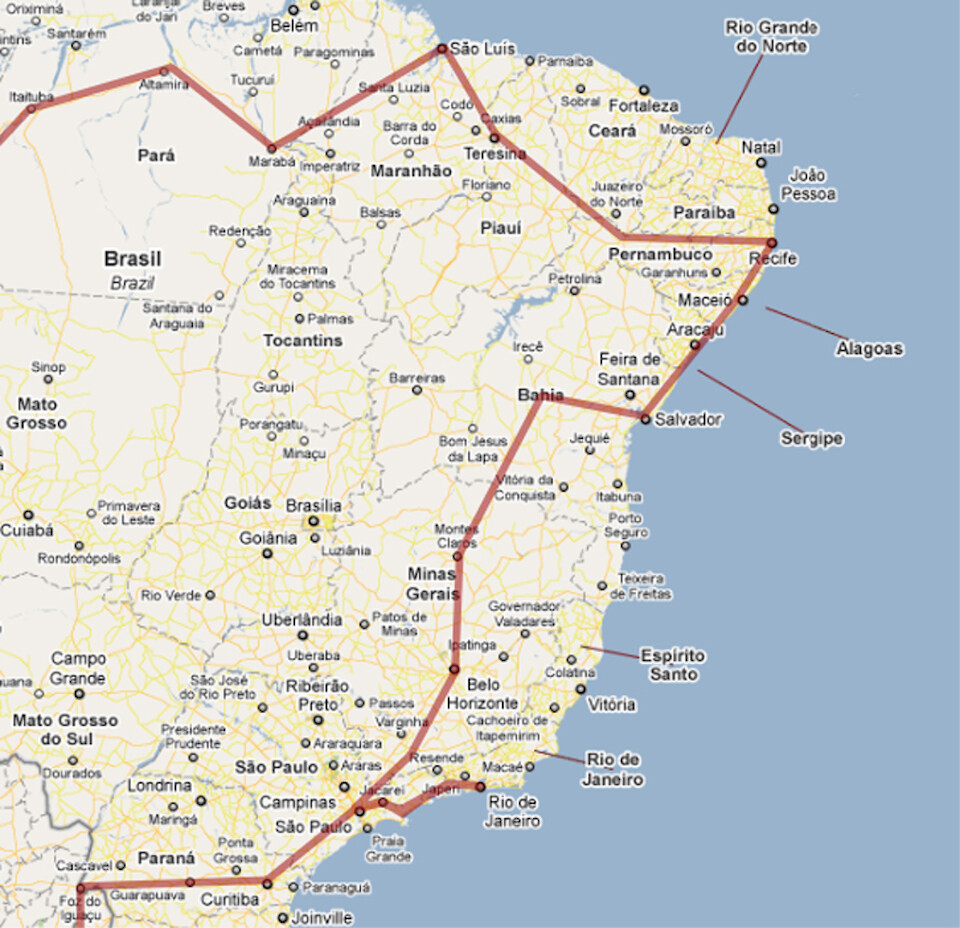
My route from Sao Luis in northern Brazil down the coast and interior to Sao Paulo and Rio, exiting at Foz da Iguazu to Argentina. Click on it to go to the interactive version in Google Maps.

Heading down BR-316 to Teresina.
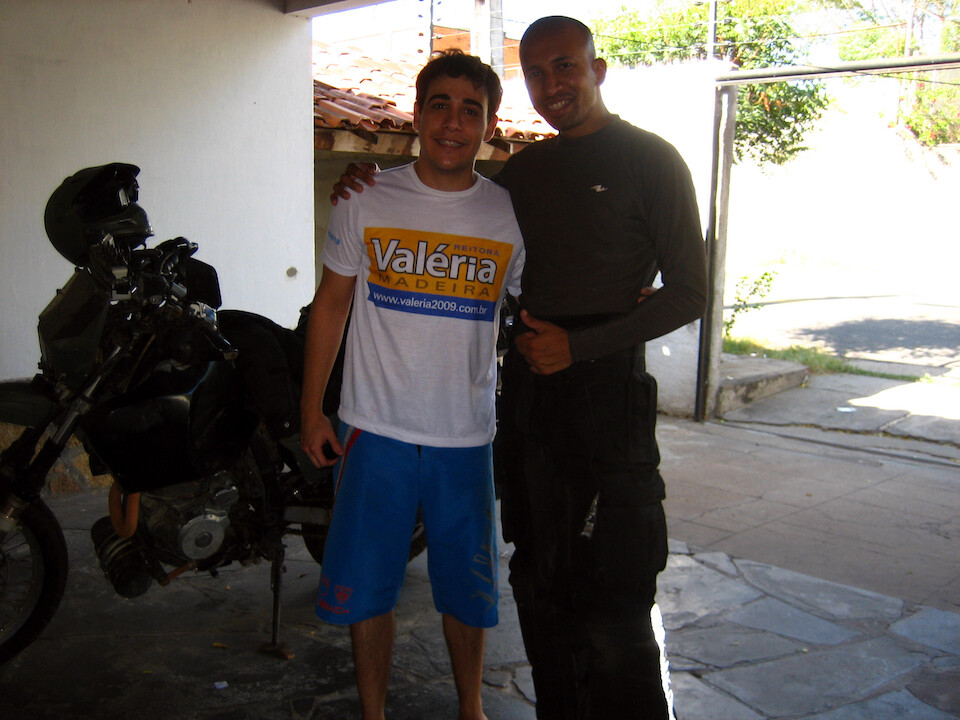
I stayed with Gustavo thru CS in this interior city of Teresina, which was noticeably hotter than Sao Luis, where it was warm but a constant breeze kept things cool. He traveled to Argentina recently, so I got some tips on Buenos Aires from him.
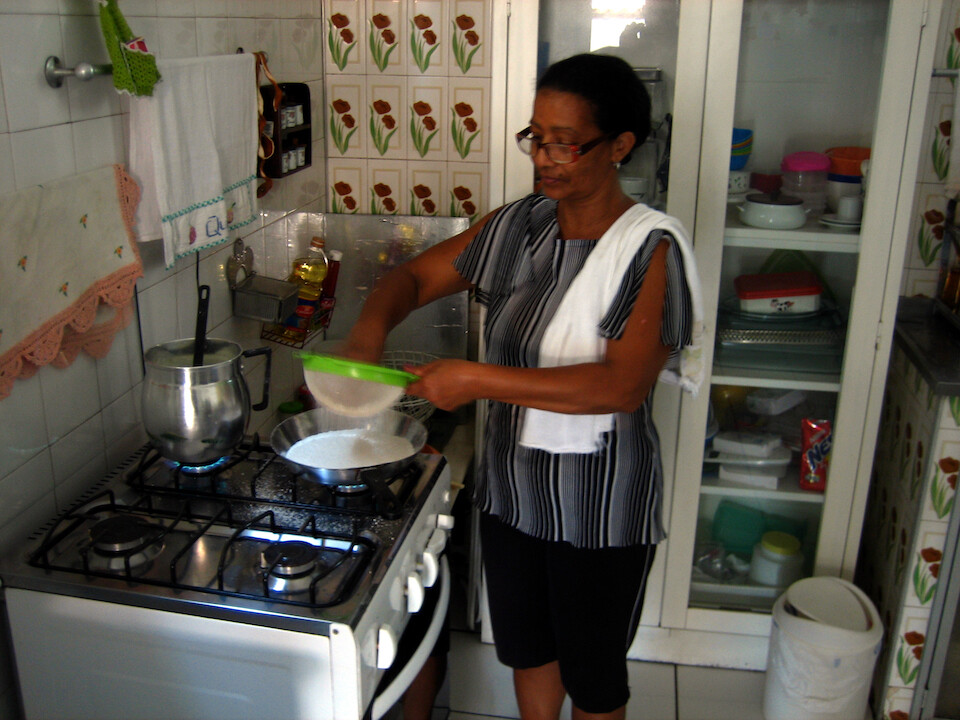
His maid prepared some tapioca pancakes for breakfast.

Tapioca pancakes with eggs. This is a typical dish for northern Brazil and I had some sweetened versions of this in Sao Luis. The flour is heated in a pan with no oil, so it's a bit healthy in that respect.
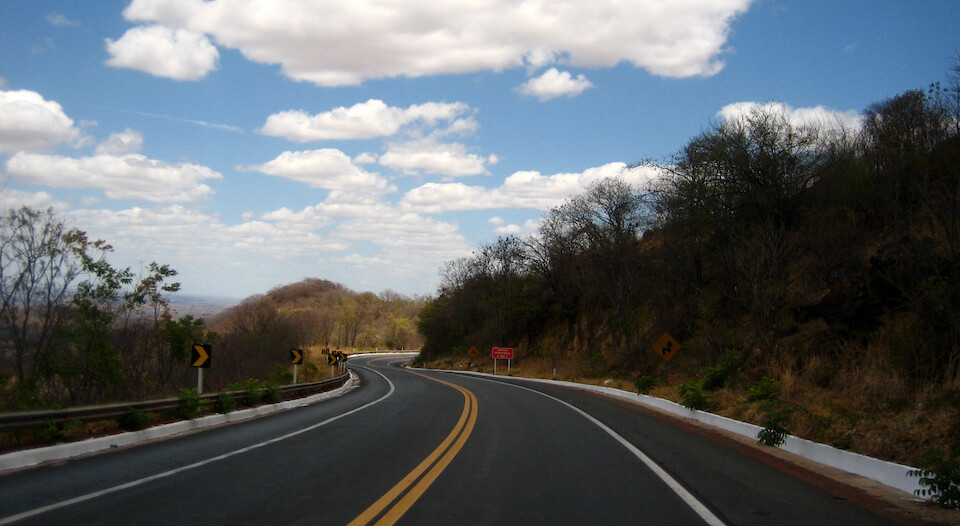
One of the few curves on BR-316, heading to Salgueiro. These roads were not as busy and they were well-maintained.
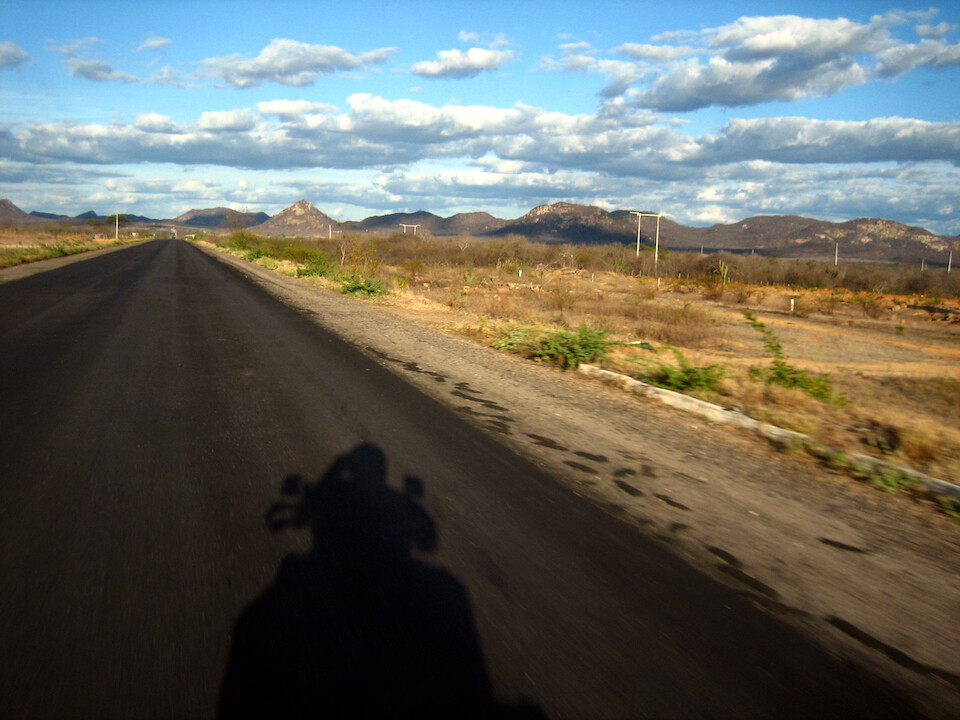
Riding into dusk, hashing out the miles. One of my longer days, 622 kms (387 mi). Being generally flat and remote with not too many towns to pass through, it was easier to keep up the average speed.
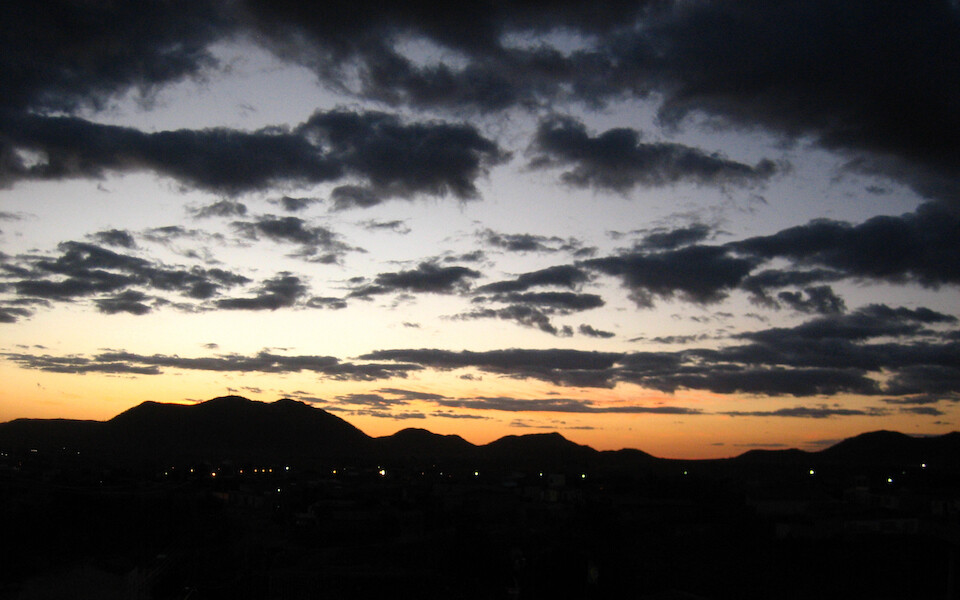
Sunset in Salgueiro, a cross-roads town with roads heading east to Recife, north to Fortaleza and south to Salvador.
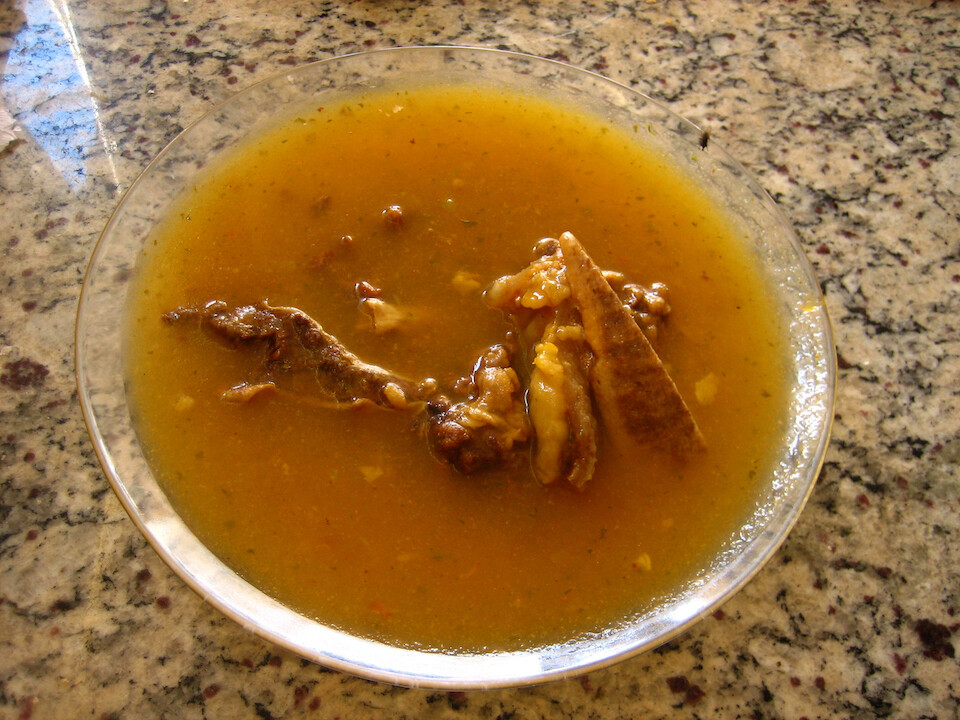
I stayed in a pousada for R\$ 20 and got some dinner at the cafe at a nearby gas station. This is some lamb soup.
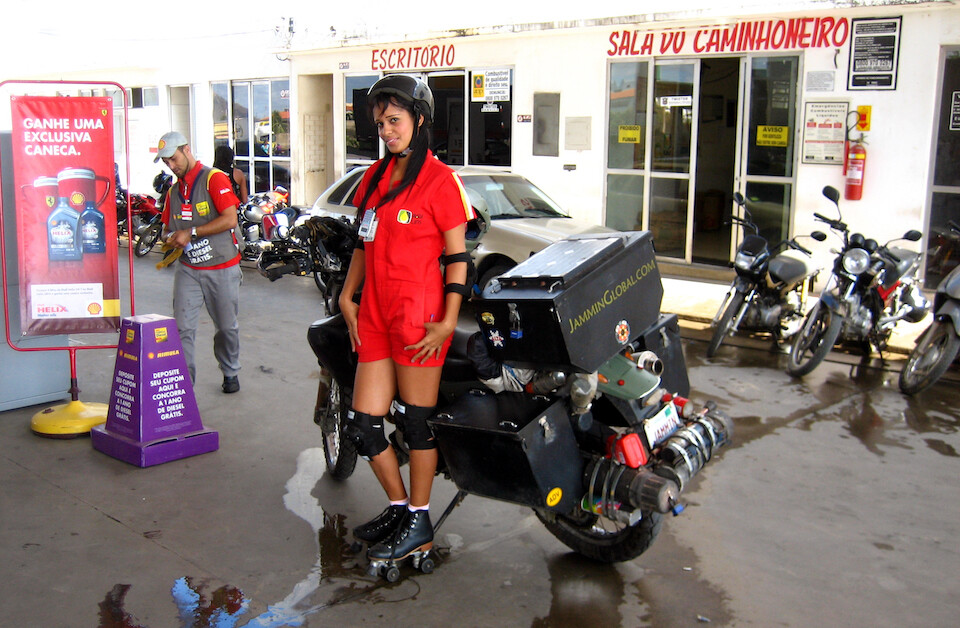
What better way to get customers to stop by then having a roller petro girl. She was handing out receipts and serving up the free coffee that's available at most gas stations in Brazil.
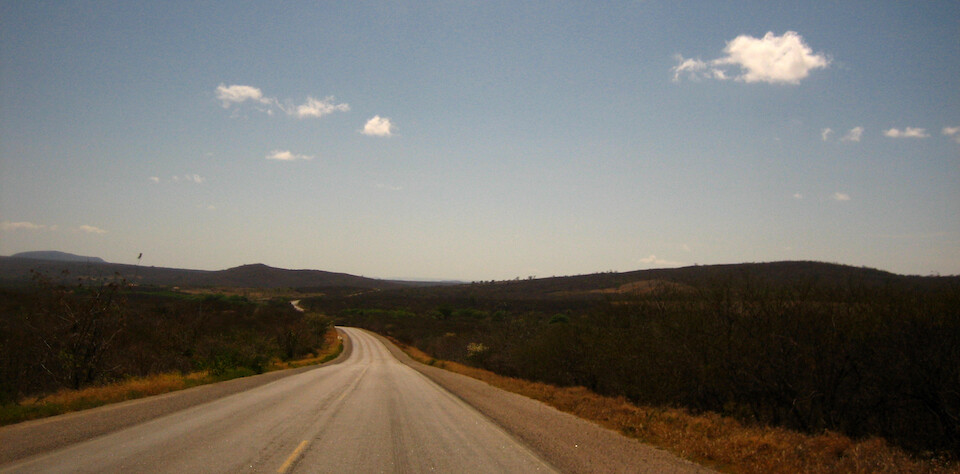
Continuing east on BR-232 towards Recife.

I rode through my first rain shower in Brazil, but it was only for a short while.
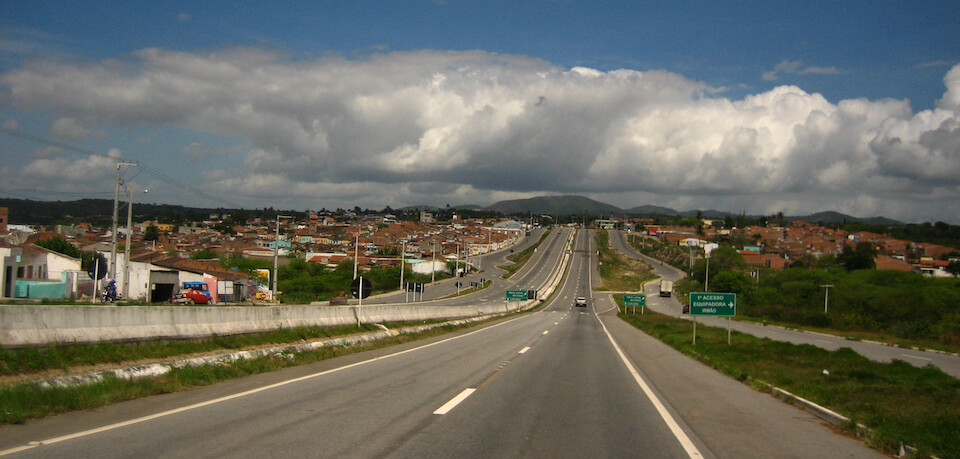
Close to the big city of Recife, the road turned into a freeway.
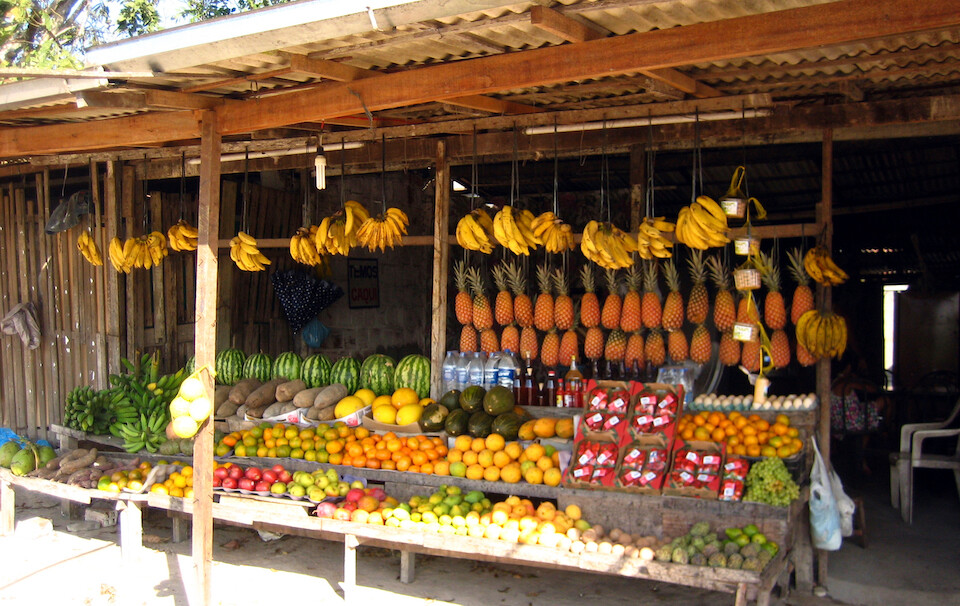
I was just snacking on nuts as it was another high mileage day, but I had to stop at this fruit stand for a little extra snack and fiber.
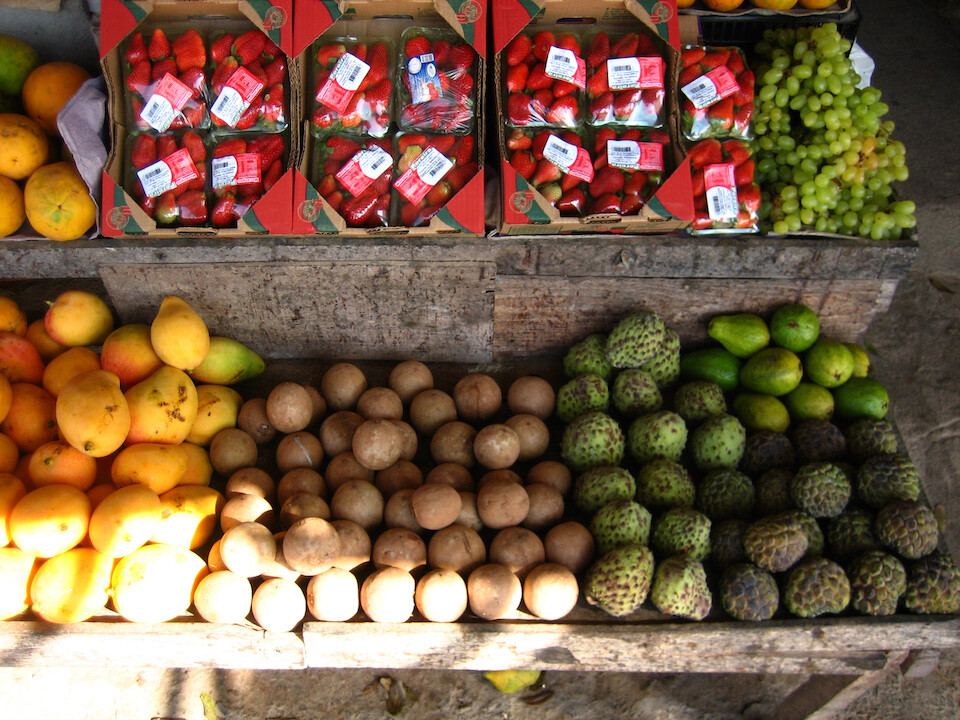
I was delighted to find many fruits that I haven't seen or tasted since India. The ones in the lower right are custard-apples, which I had in Ecuador and Peru, but they were much cheaper here. It's a very sweet fruit and I couldn't eat just one. Next to it, the brown fruit is officially called manilkara zapota, but known in India as sapota or chikoo. This I haven't seen outside of India, so I gorged on a few of them. It's also very sweet with a malty, almost caramel flavor. I also had some Jackfruit, another typical fruit of my home land.
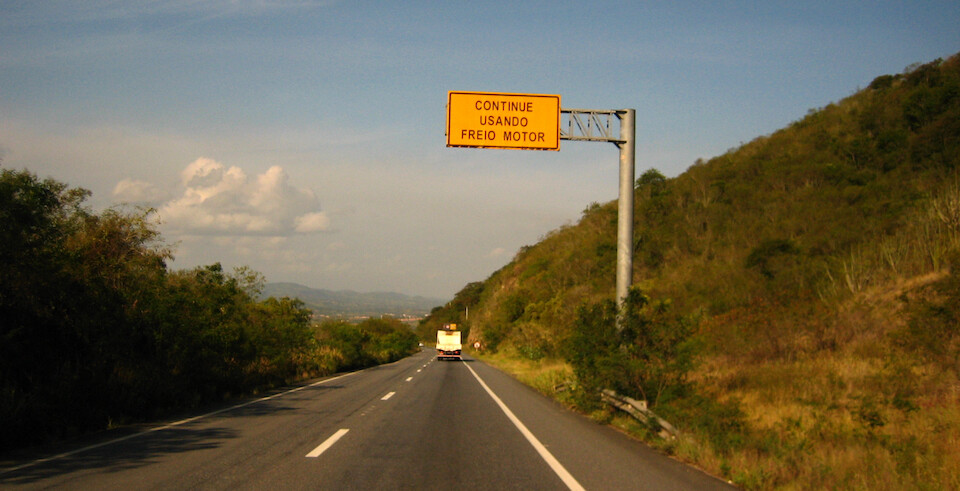
Loaded up on glucose, I was ready to enter my first big city in a long time. Recife is the biggest city in the northeast of Brazil and is the fourth largest city in the country. The road was running on a plateau for a while and slowly dropped down to the coast. The signs says "continue to use engine brake."
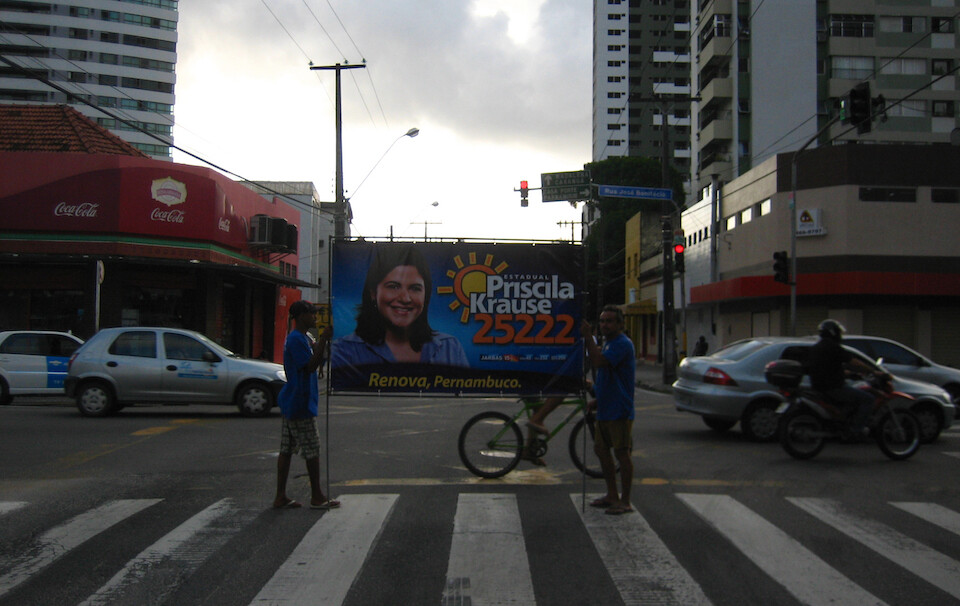
Waiting at a traffic light in Recife and you can tell the election campaigning is heating up.
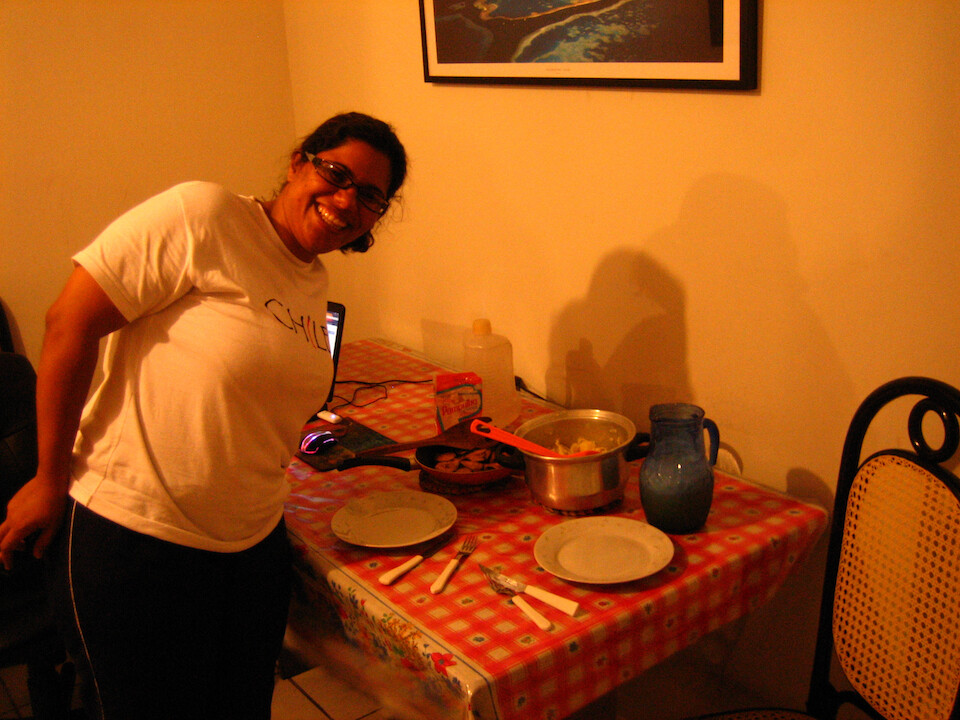
I stayed with Barbara, thru CS and she cooked up a nice eggplant lasagna, which I noted down the recipe for. She's a marine biologist and just came back recently from a dream dive in the Great Barrier Reef. She specializes in coral reproduction and Recife (which means reef in Portuguese) is suitably a good location for her research. I enjoyed learning a bit about corals from her and the unique way that these animals reproduce: synchronous spawning under a full moon.
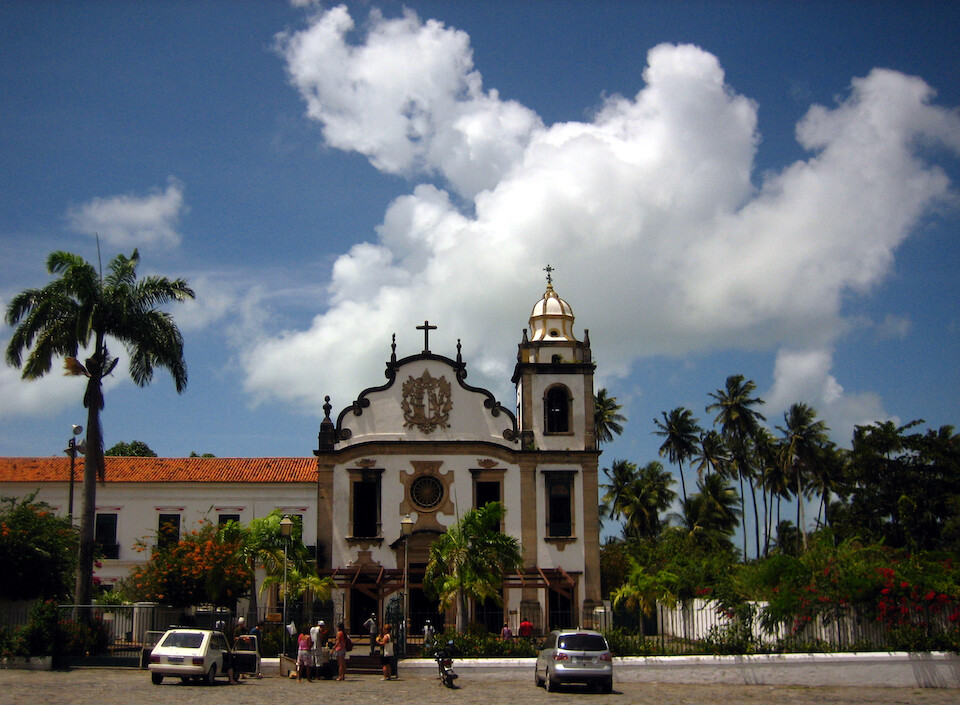
Next to the concrete jungle of Recife is the lovely little colonial town of Olinda, known for its numerous churches and unique carnival celebrations. It was founded in 1537 and facing pressure from the new protestant movement in mainland Europe, the Catholic church sought to increase their influence in the New World by increasing the rate of converting the local 'savages' and they needed lots of churches to get that done. This is the Mosteiro de São Bento, built in the 16th century along with most of the others churches here.
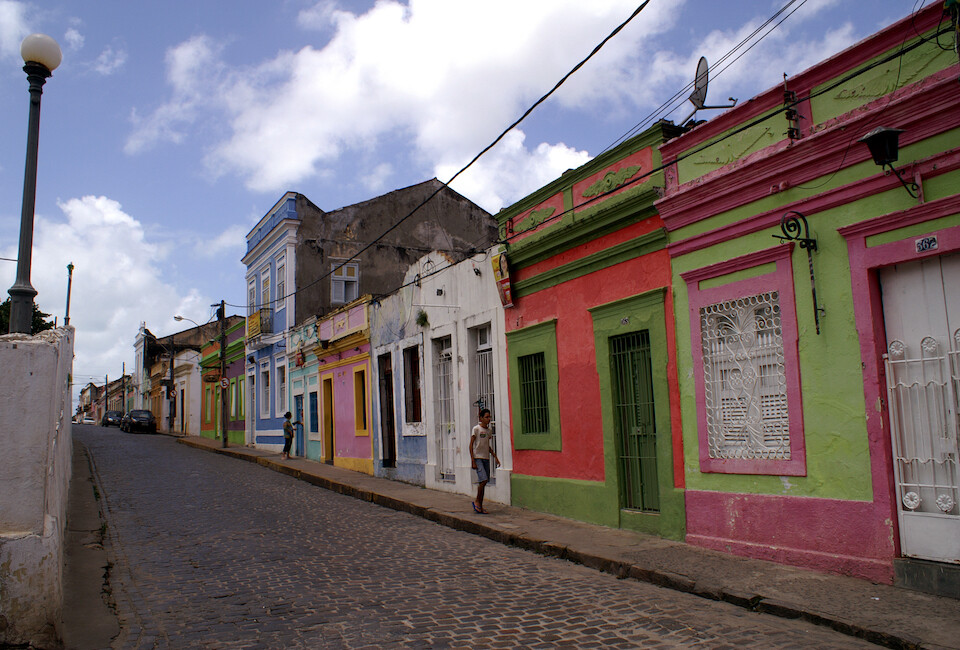
The colorful streets of Olinda, a good example of well-preserved Portuguese colonial architecture.
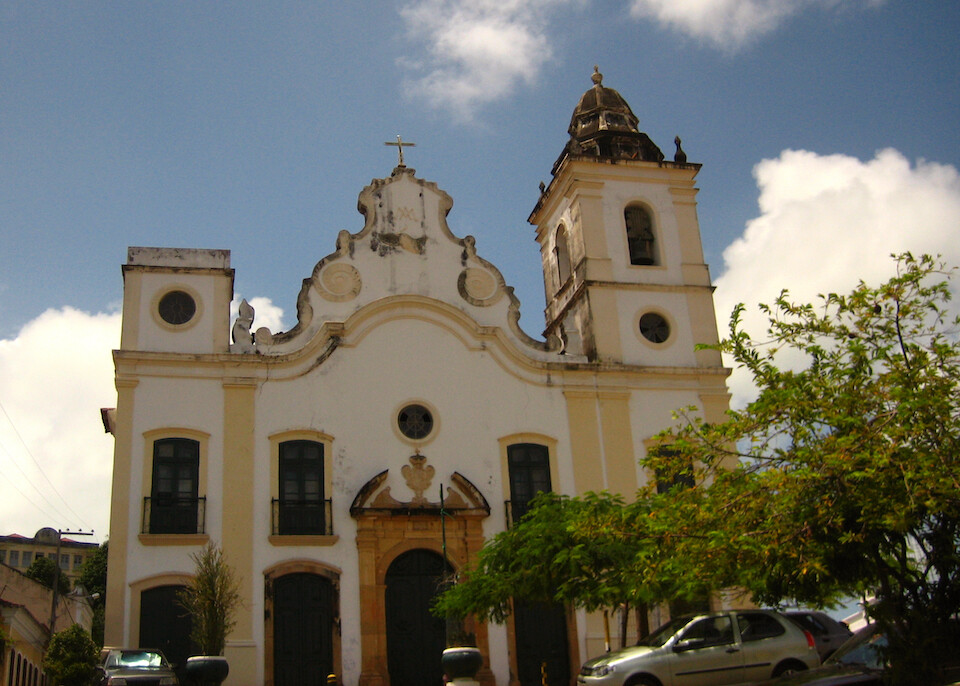
Igreja do Amparo (Church of Our Lady of Amparo, which means shelter, protection in Portuguese). This church was founded by musicians in the mid 16th century and was dedicated to Saint Cecilia, the protector of musicians. Between 1580 and 1640, Portugal and Spain were united and taking advantage of the Portuguese weakness at this time, many of their colonies were take over by other imperialists. The Dutch, through the Dutch West India Company, seized Olinda along with other towns along the coast, all the way up to Sao Luis. They were quite brutal in their take overs and burnt most of the churches down, since they were protestants. When Portugal separated from the Iberian Union, they reclaimed their lost colonies and the churches were rebuilt. As a side note, the Dutch East India Company were the first imperialists in India and there too, they were not nice to the locals.
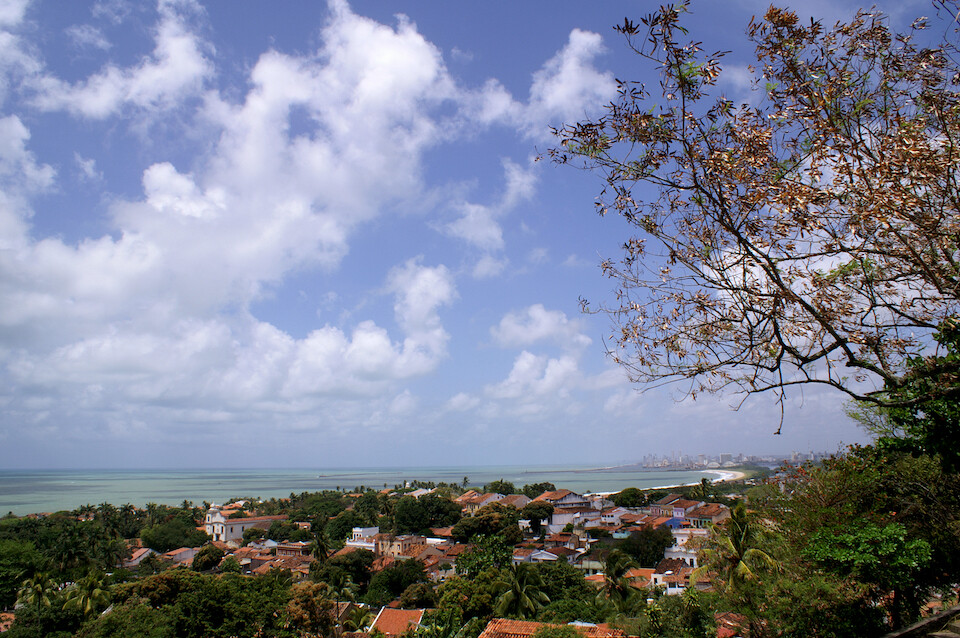
Besides all the churches, being perched on a hill, Olinda offers nice views of the ocean and that's Recife in the distance there.
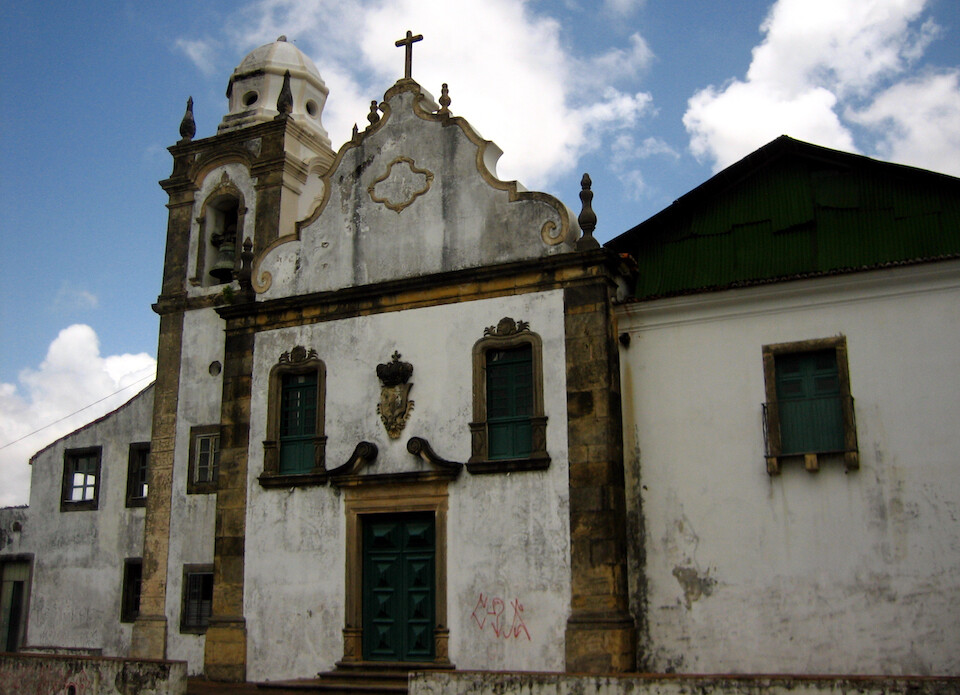
Igreja da Misericórdia (Church of Mercy), so named as it's positioned at the top of the steepest hill in Olinda, Alto da Misericórdia, and by the time you reach the top, you'll be aptly begging for mercy. It's a cobble-stoned path and was tricky going down with the bike. Next to the church, the first hospital in Brazil was built in the mid-16th century. You might've noticed that these churches oddly have only one tower and Barbara told me that it was because of tax evasion by the local churches. Every completed church in those times had to pay hefty taxes to the Roman Catholic Church back in Europe, but if your church was still under construction, you didn't have to pay taxes or maybe you paid less, so all these churches are technically still "under construction" since the second tower was never completed. And I thought people of the book were supposed to be honest :p
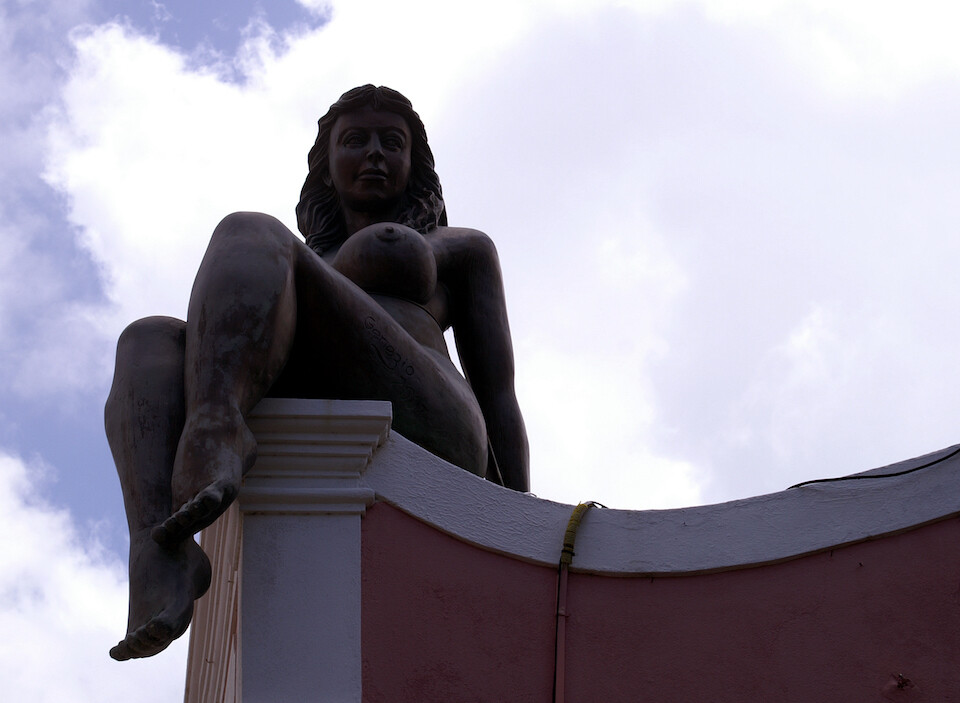
A busty sculpture perched on the corner of a building. Not only did they evade taxes, but looks like they were defying the conservatives back in the old world.

A panoramic view of Igreja da Sé (meaning cathedral), across a beautiful view of the ocean and Recife on the right side. This is the only church with two towers and thus gained the status of being the cathedral of both Olinda and Recife. The view from here is what prompted a dignitary to say "Oh, linda," meaning 'wow, beautiful.'
Click here to see the high resolution version.
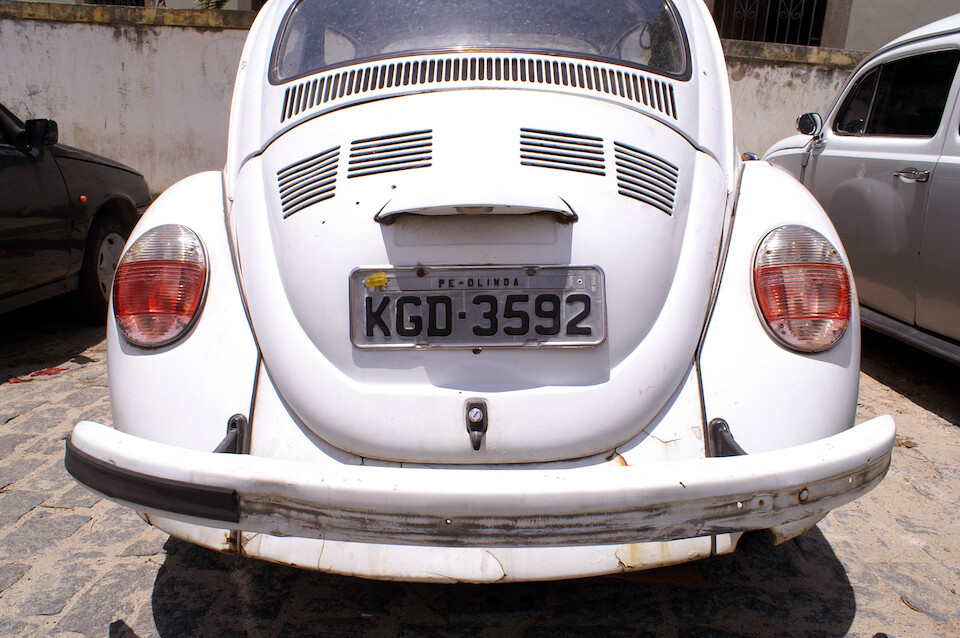
A cute VW Beetle in the parking lot. Brazil is the only country in all the Americas to have a different-sized license plate, being much longer than the ones in all the other countries. The state and the city are printed above the numerals and I guess they need the space since some city names are quite long.
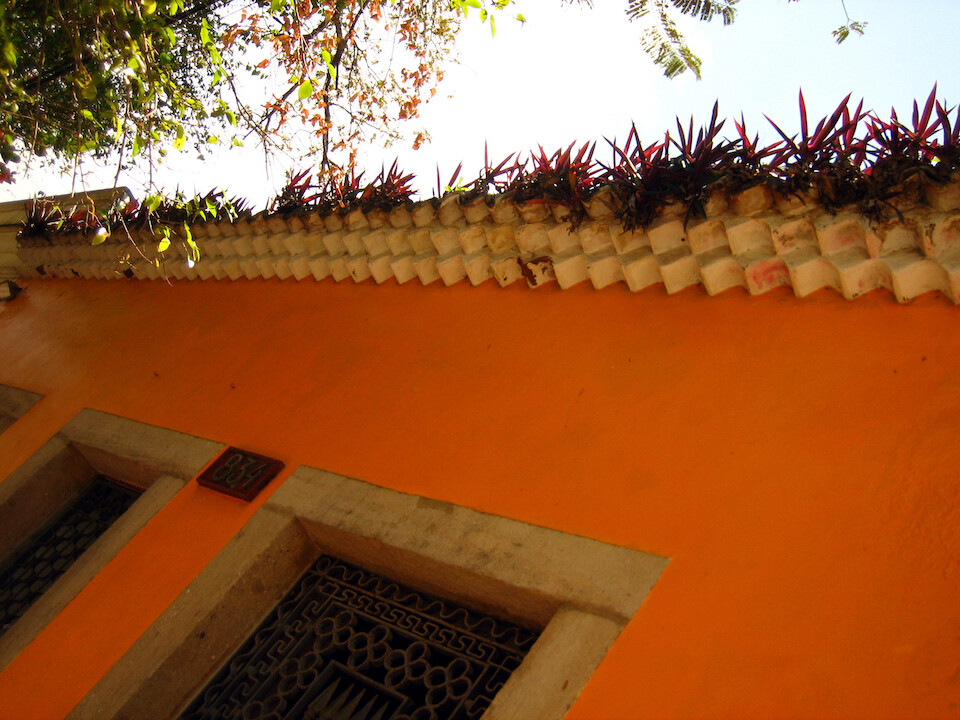
An interesting flowered roof and stone windows. It was very pleasant to walk around Olinda and I could've spent more than a day there.

The historic center of Recife.
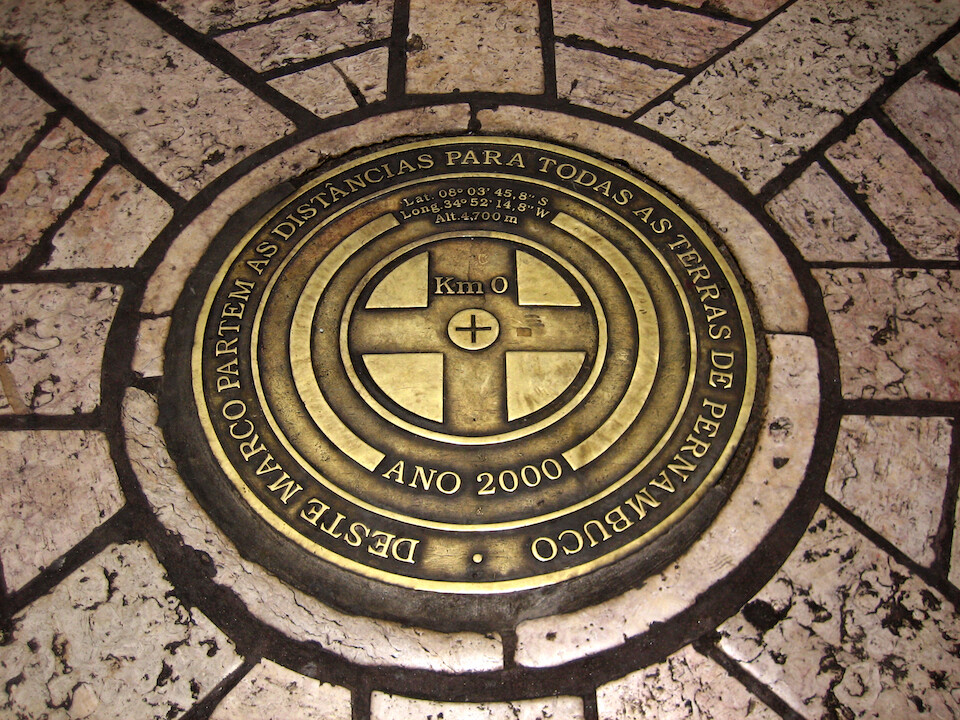
The zero marker for all the highways in the state of Pernambuco.
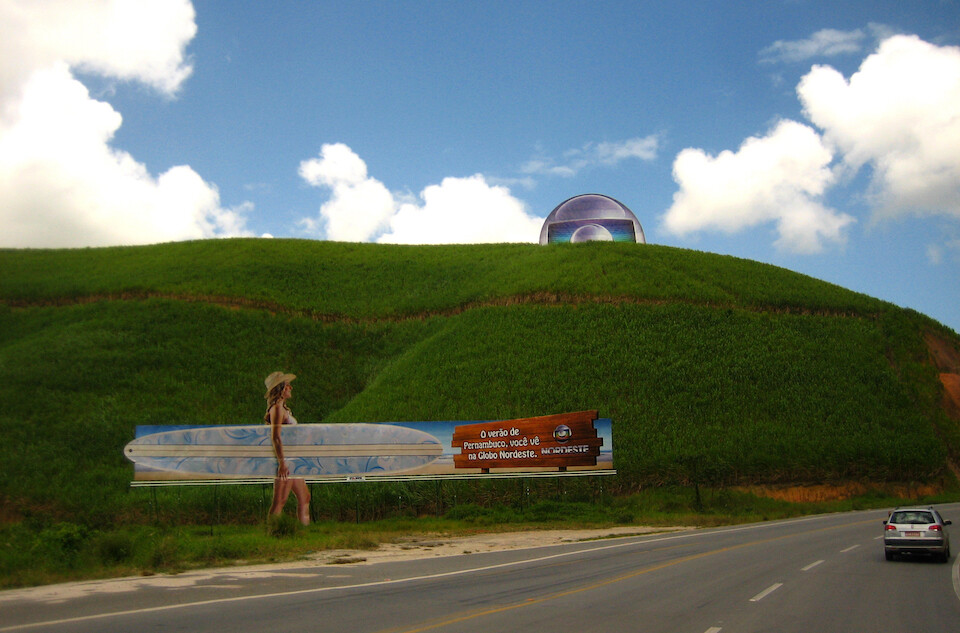
From Recife, I followed the coast down to Maceio and went in and out of a beach towns along the way. This massive surf board billboard caught my attention.

Stopping for some lunch in the beach town of Tamandaré, where Barbara's research station is based. She heads out for dives in the coral reefs from here.
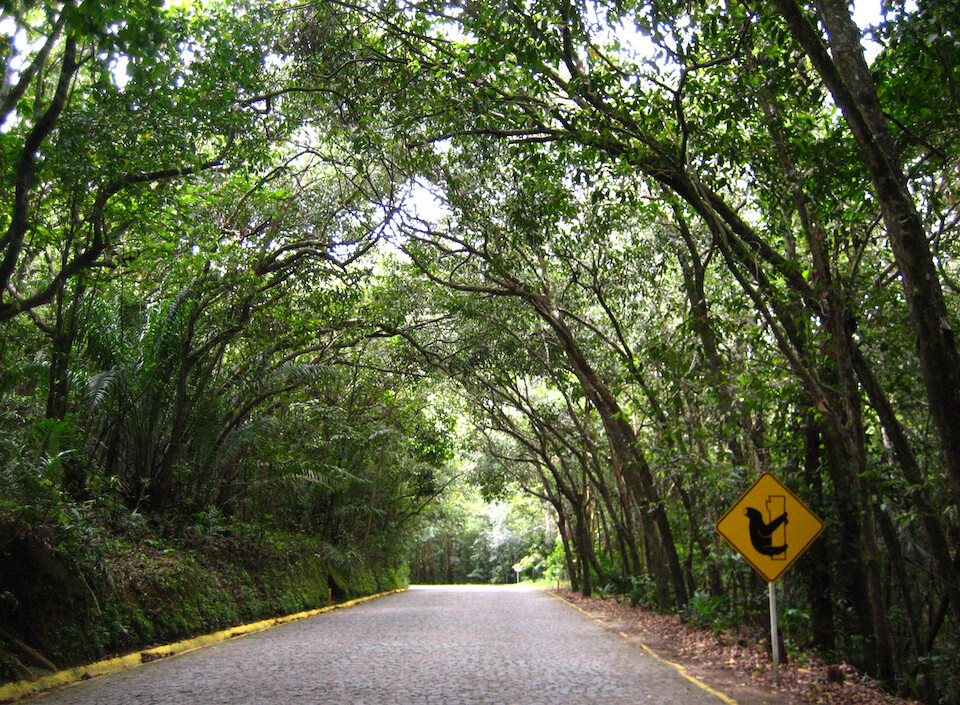
The cobble-stoned road leading back to the highway through the Mata Atlântica (the Atlantic rainforest, or more literally, the Atlantic Mat). Cute sign of a tree sloth. I waited for a while, but didn't see any.
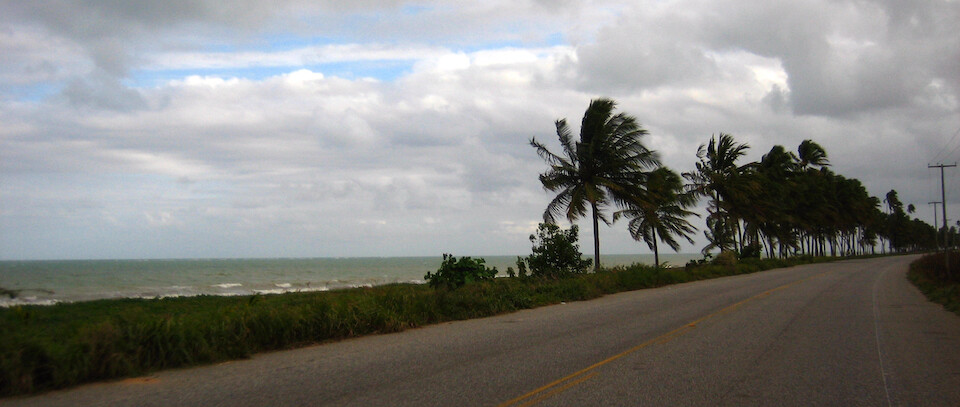
BR-101 running along the coast. There was heavy traffic on this route, but the nice views made up for that.
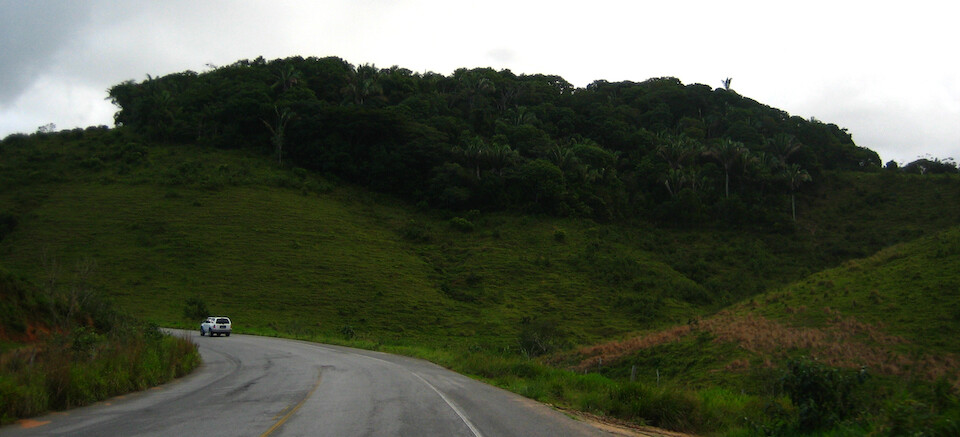
Just like in the Amazon, the hillsides here were shaved clean for sugarcane plantations but as a token to nature, they've left the tops of the hills in tact. While being a nice gesture, habitat islandization doesn't do biodiversity any good. Plants and animals need to move to thrive and the recent Convention on BioDiversity in Nagoya stressed the importance of connecting these various isolated habitats to provide a network for these ecosystems to flourish. What's the point, you might ask. Well, most of these habitats are surrounded by agriculture that depend on various services from the ecosystem for free, such as pollination and disease control. The worldwide reduction in the number of bees is causing alarm in many countries.
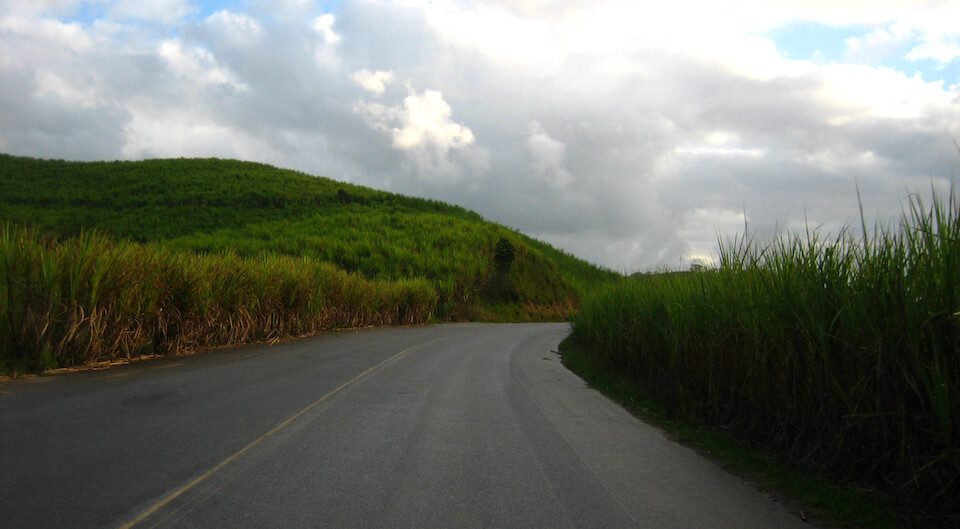
Brazil and the ubiquitous sugarcane plantations. The colonialists removed most of the Atlantic Rainforest for the sake of producing sugar for Europe and this lead to the mass slavery trade from Africa. And in the mid 1970's, following the Arab Oil Embargo, Brazil harnessed ethanol production from sugarcane and created conditions to encourage the domestic use of this fuel in automobiles instead of gasoline and thus reduced their dependence on imported oil. Today, all new cars and most older ones can run on pure ethanol or the other option of 25% ethanol in the gasoline. Ethanol burns leaner, so foreign vehicles need a few adjustments to run efficiently. This biofuel success story encouraged other countries to follow suit and whilst initially looking like a very green solution to fossil fuels, the food price crisis in 2008 highlighted the double-edged sword of biofuels, in that they are taking up food production land and driving up the prices of food around the world, which seems highly immoral considering the billion or so humans who are going hungry everyday.
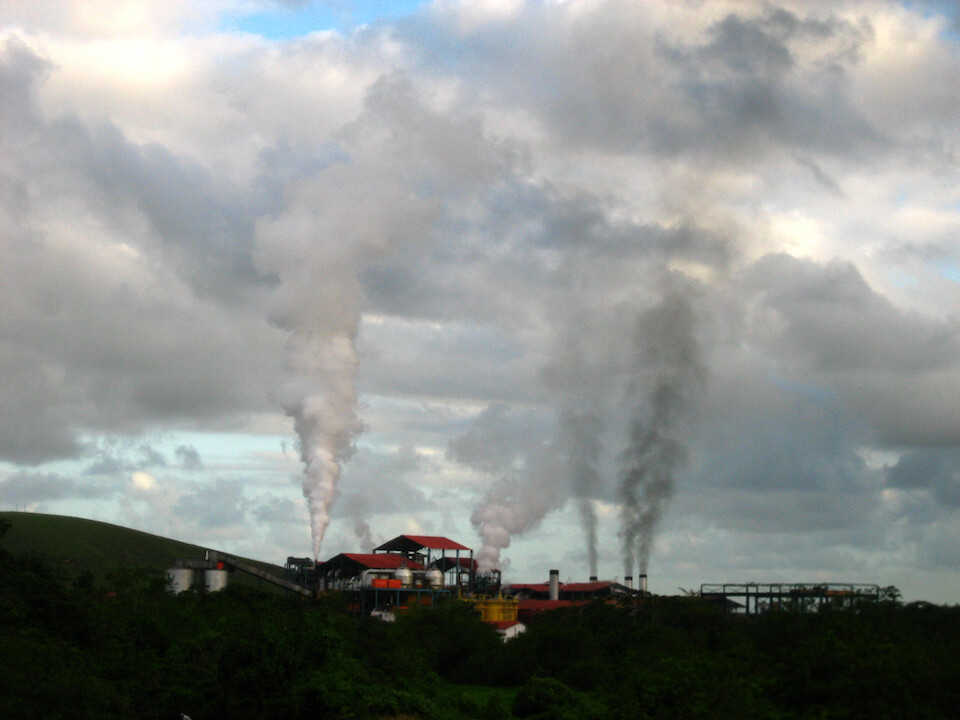
A sugarcane milling plant, located in close proximity to the sugarcane fields, since once the stalks are cut, they have to be processed quickly. Brown or raw sugar is made in these milling plants and then white or refined sugar is made closer to where it's consumed.
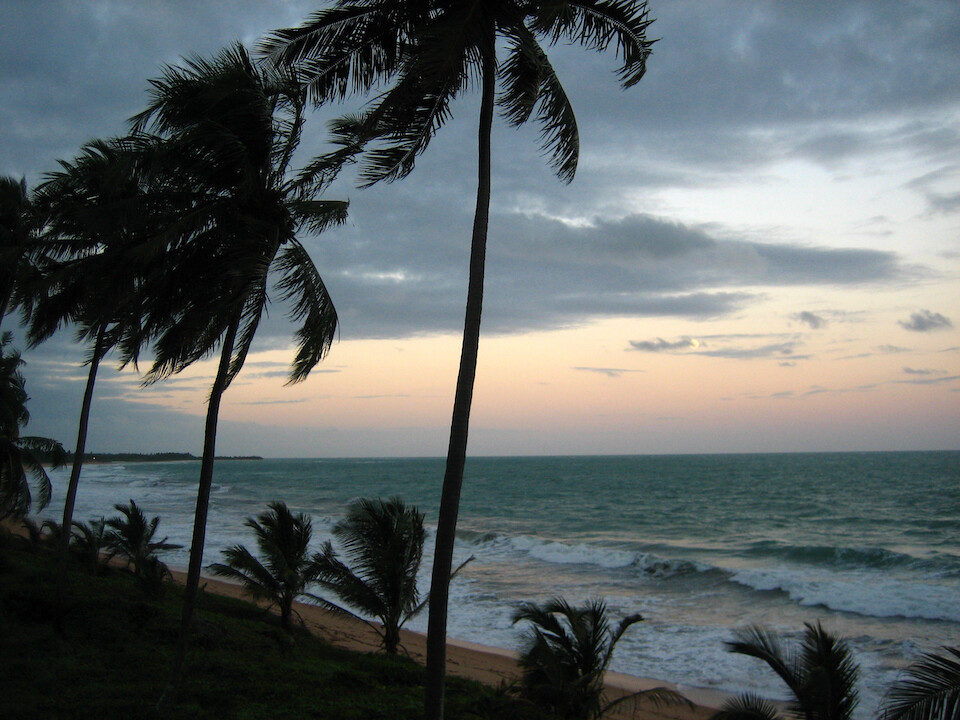
Taking in the sunset by the beach road. It got dark as I rode into Maceio, the capital of the next state south of Alagoas.
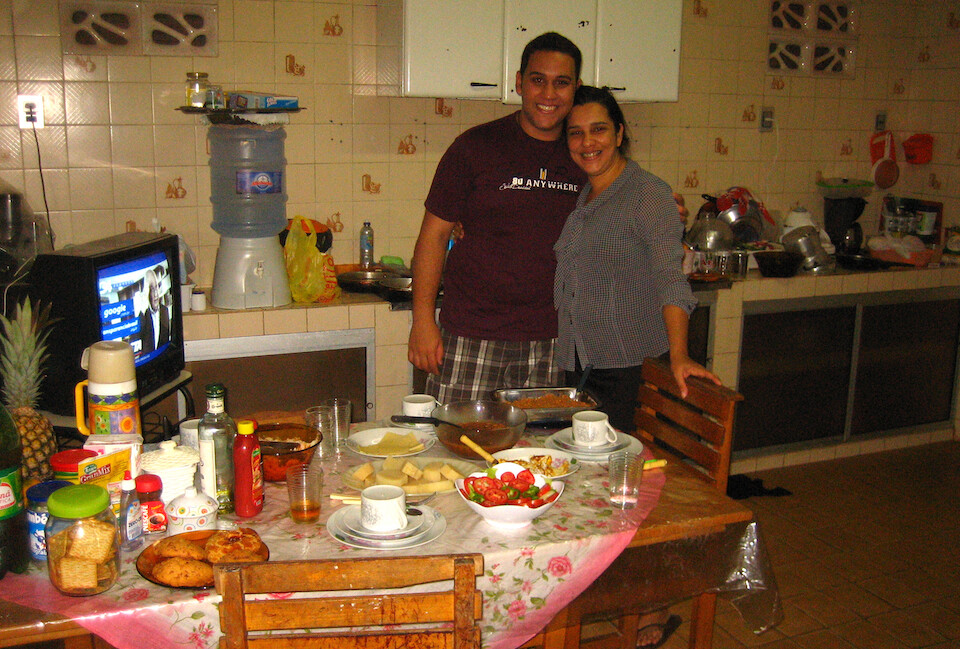
Being welcomed by Bruno and his mother. He's part of the choir at his university (glee club) and traveled to Germany a few months back for a competition and their song from the Amazon with the choir mimicking the sounds of the jungle won them first place.
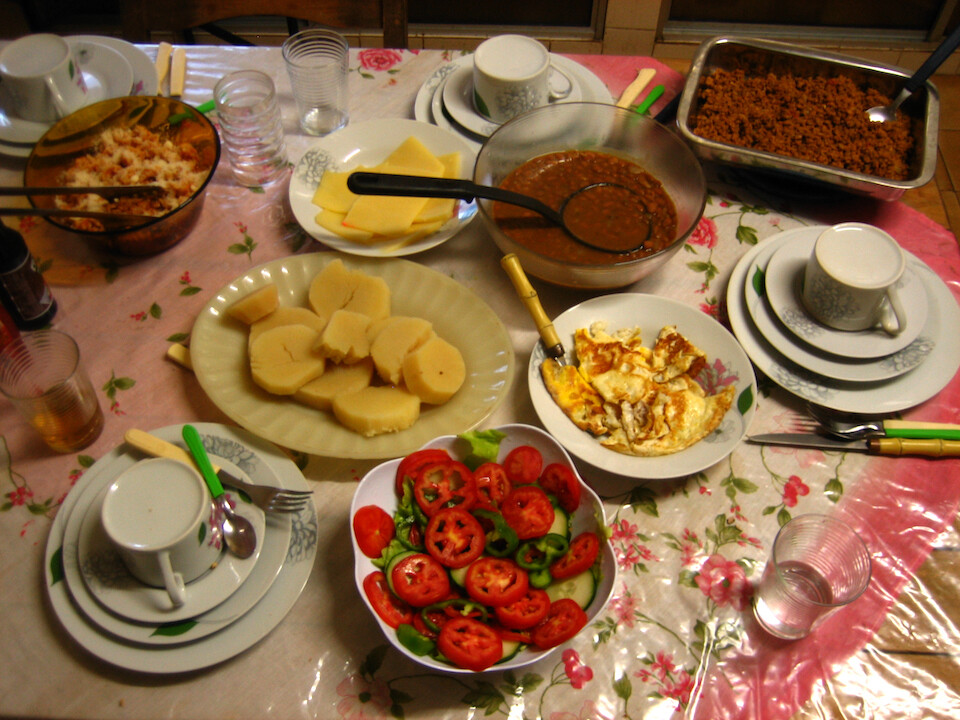
His mother prepared numerous different items. The yellow root in the middle resembled the texture of turnips but tasted much better.
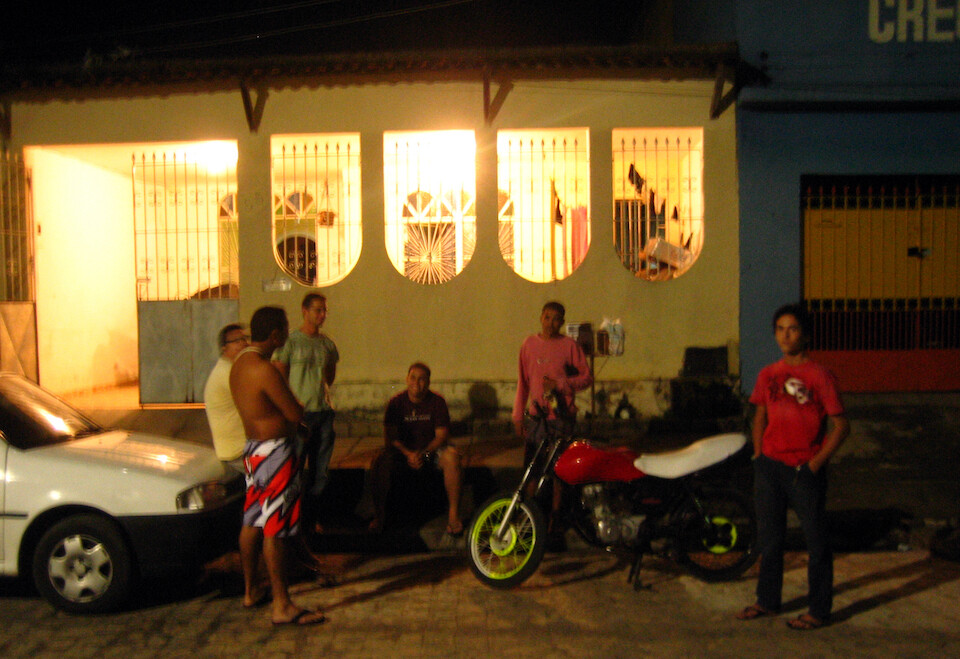
Hanging out in front of Bruno's house with his dad, brother and this young kid in the red t-shirt was an up and coming stunt rider.
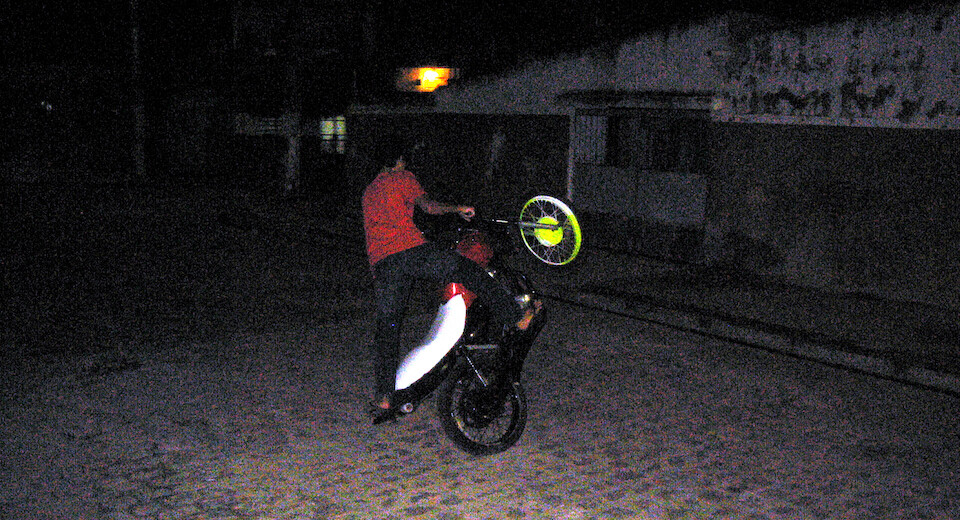
He put on quite a show on his 125cc stunt bike with sandals and no helmet.
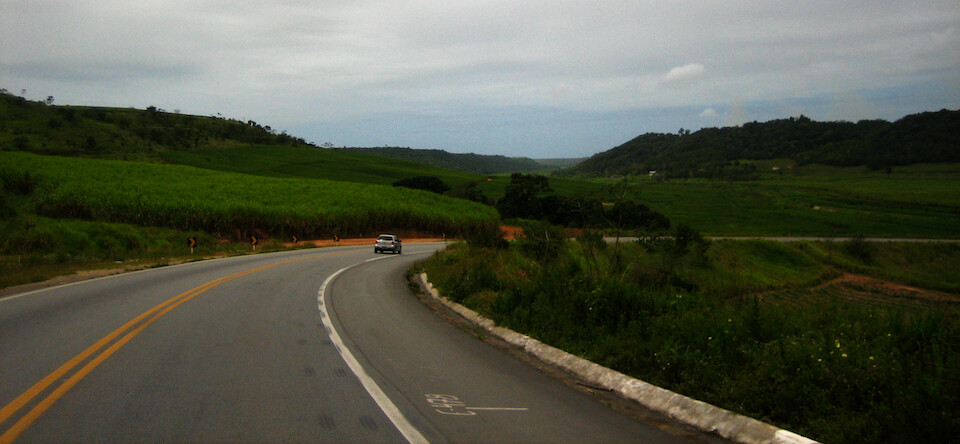
Continuing south the next day to Salvador on BR-101. This highway runs along almost the entire coast of Brazil. In some places, it's the only major highway and thus sees a lot of truck traffic, like through here.
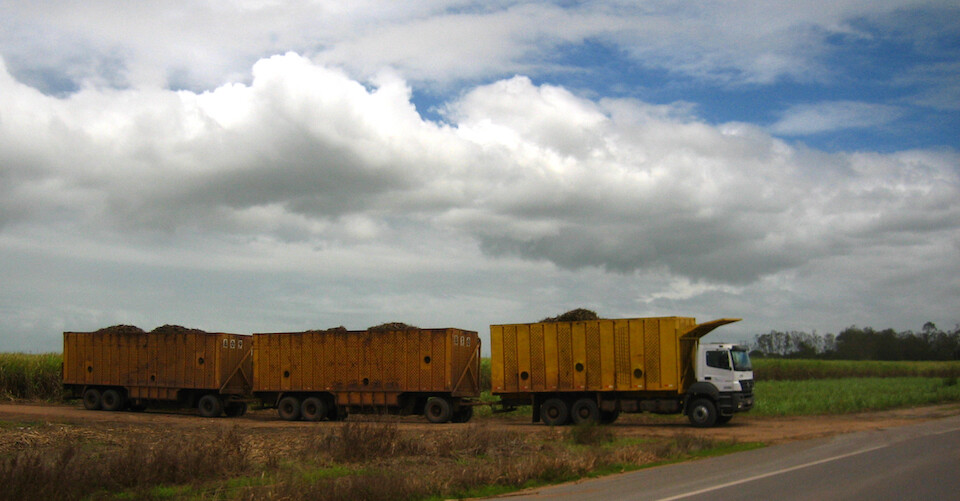
A road-train hauling freshly cut sugarcane to a nearby mill.
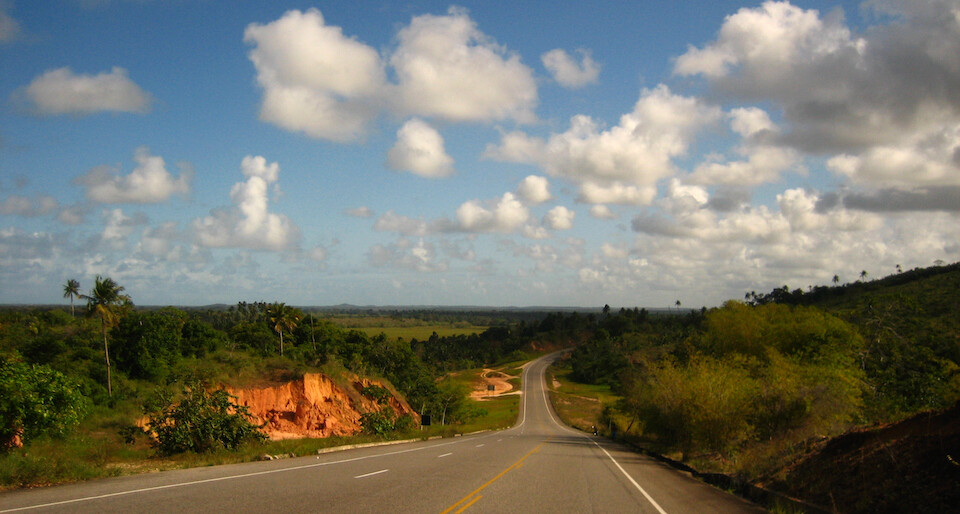
Splitting off from the busy BR-101 and riding the more tranquil BA-99, Bahia state highway to Salvador, the state capital.
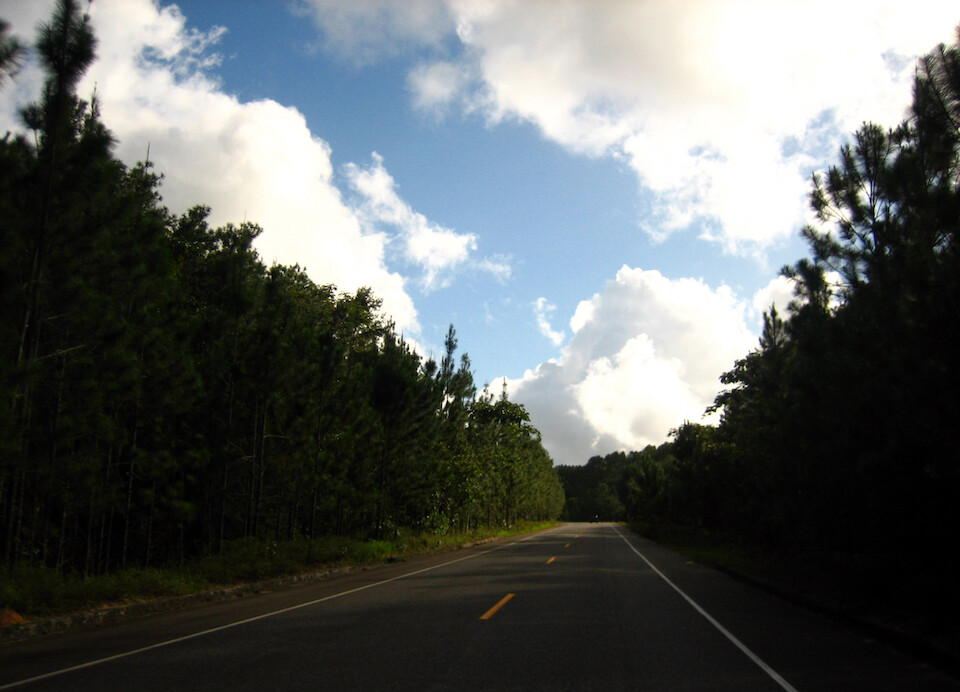
Riding through the Linea Verde (green line) or intact Atlantic Rainforest just north of the city. It was a welcome change after riding through endless sugarcane plantations.
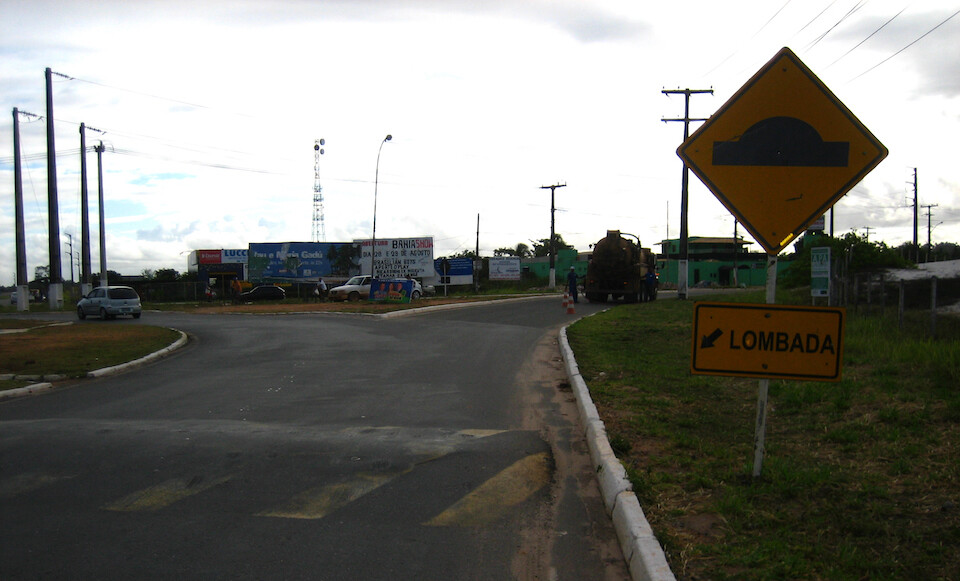
The speed bumps in Brazil, called Lombadas, probably having some connection to the forbidden dance of Lambada. Brazil loves speed bumps almost as much as Mexico. Maybe the more developed a developing country is, the more speed bumps it uses until finally it can afford enough of a police force to actually enforce the speed limit instead of draconian bumps in the road.